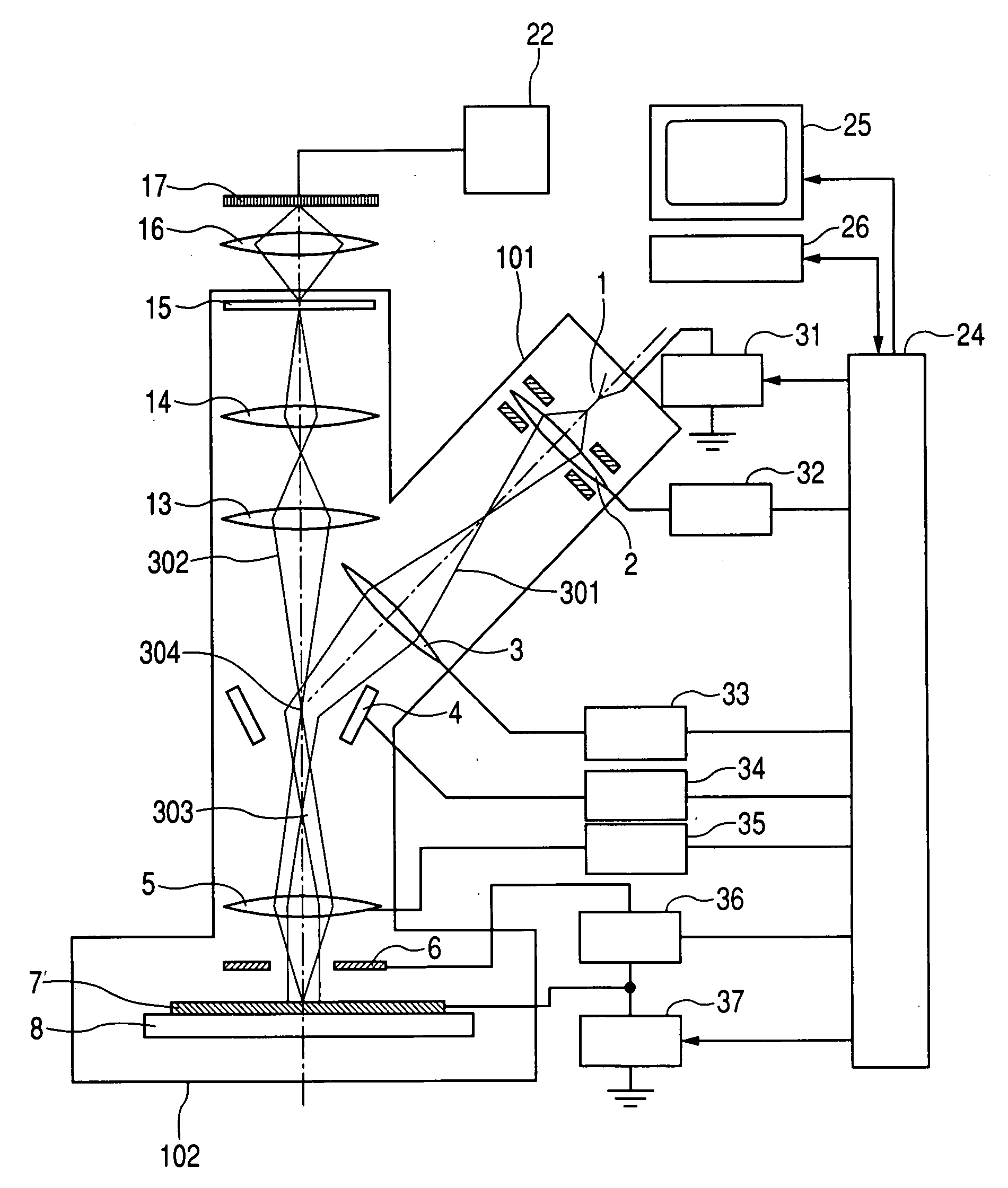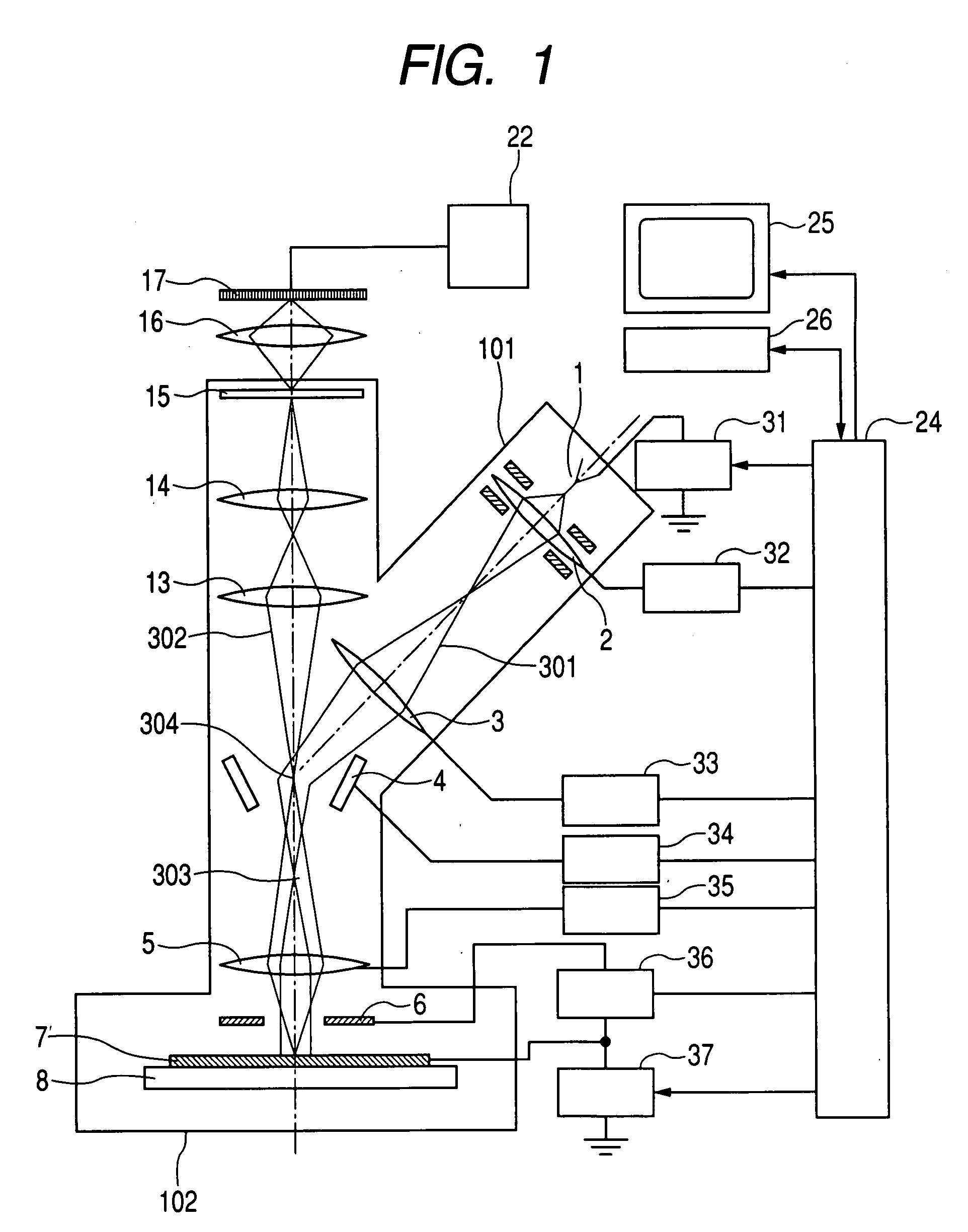Electron microscope and electron bean inspection system.
a technology of electron bean and electron microscope, which is applied in the direction of material analysis using wave/particle radiation, instruments, nuclear engineering, etc., can solve the problems of low rate of secondary electron usable for image forming, the microscope projector that uses secondary electrons and mirror electrons suffers, and the rate of secondary electrons is not always available for image forming, etc., to avoid degradation of image resolution, high energy part, and high resolution image
- Summary
- Abstract
- Description
- Claims
- Application Information
AI Technical Summary
Benefits of technology
Problems solved by technology
Method used
Image
Examples
first embodiment
[0048]FIG. 1 shows a configuration of a mirror electron beam microscope for describing the operation in the first embodiment. An ExB deflector 4 used as a beam separator is disposed nearly to an imaging plane of a reflecting electron beam 302 that includes a mirror electron beam. An illumination system optical axis and an imaging system optical axis perpendicular to a wafer 7 respectively cross each other at a θIN angle. As described above, because an ExB deflector 4 used as a beam separator is disposed between a condenser 3 and an objective lens 5, the illuminating electron beam 301 emitted from an electron source 1 is deflected by the ExB deflector 4 to an optical axis perpendicular to the wafer 7. Electrons of the illuminating electron beam 301 deflected by the ExB deflector 4 are focused by the condenser lens 3 in the vicinity of a focal plane 303 of the objective lens 5, thereby the electrons of the illuminating electron beam 301 are illuminated onto the specimen 7 almost in pa...
second embodiment
[0063]In this second embodiment shown in FIG. 2, an energy filter is mounted in an illuminating system of a mirror electron microscope to control the mirror reflecting plane. An energy filter 9 is disposed between an electron gun lens 2 and a condenser lens 3. An illuminating electron beam 101 emitted from an electron source 1 and passed through the energy filter 9 forms an energy-dispersed cross-over between the energy filter 9 and the condenser lens 3. On the cross-over is disposed a limiting stop 11 for selecting an energy of the illuminating electron beam. The illuminating electron beam 101 of which energy is selected is deflected to an optical axis perpendicular to a wafer 7 by a beam separator 4 disposed between the condenser lens 3 and an objective lens 5, then focused in the vicinity of an objective lens focal plane 303 by the condenser lens 3. The electrons of the illuminating electron beam can thus be illuminated perpendicularly onto a specimen 7 almost in parallel. The li...
third embodiment
[0072]In this third embodiment shown in FIG. 3, a mirror electron microscope is employed for quick wafer inspection. An electron source 1 is a Zr / 0 / W type Schottky electron source having a tip of which radius is about 1 μm. With the use of this electron source, a uniform planar electron beam can be formed stably with a large current (ex., 1.5μ A) and at an energy width of 0.5 eV or under.
[0073]An energy filter 9 is disposed between an electron gun lens 2 and a condenser lens 3 and an illuminating electron beam 301 emitted from the electron source 1 passes through the energy filter 9, then forms an energy dispersed cross-over between the energy filter 9 and the condenser lens 3. On the cross-over is disposed a limiting stop 11 used to select an energy of the illuminating electron beam 101. The illuminating electron beam 101 of which an energy is selected passes the condenser lens 3, then deflected to an optical axis perpendicular to a wafer 7 by a beam separator disposed between the ...
PUM
 Login to View More
Login to View More Abstract
Description
Claims
Application Information
 Login to View More
Login to View More - R&D
- Intellectual Property
- Life Sciences
- Materials
- Tech Scout
- Unparalleled Data Quality
- Higher Quality Content
- 60% Fewer Hallucinations
Browse by: Latest US Patents, China's latest patents, Technical Efficacy Thesaurus, Application Domain, Technology Topic, Popular Technical Reports.
© 2025 PatSnap. All rights reserved.Legal|Privacy policy|Modern Slavery Act Transparency Statement|Sitemap|About US| Contact US: help@patsnap.com



